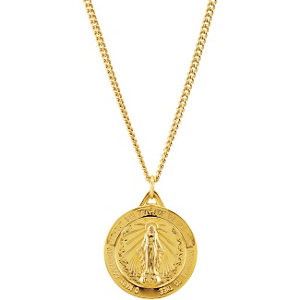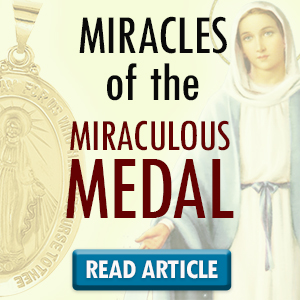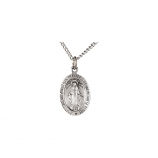- Home
- Jewelry
- Miraculous Medals
- Patron Saint Medals
- *By Patronage
- Patron Saint of Abuse Victims
- Patron Saint of Accommodations and Cats
- Patron Saint of Accountants and Bankers
- Patron Saint of Actors and Comedians
- Patron Saint of Adopted Children
- Patron Saint of Advertising and Lung Problems
- Patron Saint of Africa
- Patron Saint of Against Arthritis and Spain
- Patron Saint of Against Hailstorms
- Patron Saint of Against Poverty
- Patron Saint of Against Racism
- Patron Saint of Agricultural Workers
- Patron Saint of Aids and Teenagers
- Patron Saint of Alcholism and Carpenters
- Patron Saint of Alcoholics and The Sick
- Patron Saint of Altar Boys and Altar Girls
- Patron Saint of Altar Servers
- Patron Saint of Americas and Natives
- Patron Saint of Anesthesiologists
- Patron Saint of Animals and Catholic Action
- Patron Saint of Animals and Gravediggers
- Patron Saint of Archers and Hunters and Dogs
- Patron Saint of Architects and Blind People
- Patron Saint of Architects and Sudden Death
- Patron Saint of Arm Pain and Bruises
- Patron Saint of Artists and Liberal Arts
- Patron Saint of Astronomy
- Patron Saint of Athletes and Soldiers
- Patron Saint of Authors and Teachers and Deafness
- Patron Saint of Auto Routes and Road Workers
- Patron Saint of Aviators
- Patron Saint of Aviators and Florists
- Patron Saint of Bachelors and Dogs
- Patron Saint of Bachelors and Poland
- Patron Saint of Bakers and Brides and Children
- Patron Saint of Bakers and Homeless
- Patron Saint of Barcelona Spain
- Patron Saint of Beekeepers and Candlemakers
- Patron Saint of Bi-Racial People
- Patron Saint of Birdflu
- Patron Saint of Blackbirds and Ireland
- Patron Saint of Blacksmiths and Jewelers
- Patron Saint of Blind and Love and Safe Journey
- Patron Saint of Blind and Paralyzed
- Patron Saint of Blood Banks
- Patron Saint of Bowel Disorders
- Patron Saint of Boy Scouts and Soldiers
- Patron Saint of Brewers
- Patron Saint of Brewers and Theologians
- Patron Saint of Broken Bones
- Patron Saint of Builders and Parenthood
- Patron Saint of Butchers and Fisherman
- Patron Saint of Cancer and Running Sores
- Patron Saint of Cancer Patients
- Patron Saint of Carpenters and Dying and Fathers
- Patron Saint of Catechists
- Patron Saint of Catechists and Seminarians
- Patron Saint of Catholic Education
- Patron Saint of Catholic Schools and Students
- Patron Saint of Central America
- Patron Saint of Charities and Caregivers
- Patron Saint of Charity and Drug Abuse
- Patron Saint of Chefs and Comedians
- Patron Saint of Children
- Patron Saint of Children and Schools
- Patron Saint of Chile
- Patron Saint of Clergy
- Patron Saint of Cobblers and Cold
- Patron Saint of Cobblers and Nervous Diseases
- Patron Saint of College Students
- Patron Saint of Computers and Internet
- Patron Saint of Confessors and Priests
- Patron Saint of Confessors and Theologians
- Patron Saint of Construction Workers
- Patron Saint of Contemplatives
- Patron Saint of Corsica
- Patron Saint of Coughs and Storms
- Patron Saint of Cyclists
- Patron Saint of Deacons and Stonemasons
- Patron Saint of Death Of Children
- Patron Saint of Dental Diseases
- Patron Saint of Desperate Situations
- Patron Saint of Diabetes
- Patron Saint of Difficult Marriages
- Patron Saint of Diocese Of Ossory Ireland
- Patron Saint of Disabled and Abuse Victims
- Patron Saint of Doves and Wales
- Patron Saint of Dysentery and Against Earache
- Patron Saint of Dysfunctional Families
- Patron Saint of Earache and Animals and Epilepsy
- Patron Saint of Educators and Teachers
- Patron Saint of El Salvador
- Patron Saint of England
- Patron Saint of Engravers and Printers
- Patron Saint of Enlightenment and Germany
- Patron Saint of Environment
- Patron Saint of Epilepsy and Orators
- Patron Saint of Expectant Mothers
- Patron Saint of Eye Disease and Eye Problems
- Patron Saint of Eye Diseases and Writers
- Patron Saint of Eyes and Television
- Patron Saint of Falsely Accused
- Patron Saint of Fathers and Grandfathers
- Patron Saint of Ferns and Ireland
- Patron Saint of Fevers and Mountaineers
- Patron Saint of Fire Fighters
- Patron Saint of Fire Prevention
- Patron Saint of Firefighters and Huntsmen
- Patron Saint of First Communicants
- Patron Saint of Fisherman and Scotland
- Patron Saint of Florists and Brides
- Patron Saint of Foreign Missions
- Patron Saint of France and City Of Reims
- Patron Saint of Funeral Directors
- Patron Saint of Gardners
- Patron Saint of Handicapped and The Childless
- Patron Saint of Handicapped People
- Patron Saint of Hatters and Pastry Chefs
- Patron Saint of Head Injuries
- Patron Saint of Headache and Loss Of Parents
- Patron Saint of Headaches and Against Frenzy
- Patron Saint of Homeless People
- Patron Saint of Hospital Administrators
- Patron Saint of Hospitals and Nurses
- Patron Saint of Housekeepers and Mothers
- Patron Saint of Ice Skating
- Patron Saint of Illness and Poverty
- Patron Saint of Infants and Childbirth
- Patron Saint of Infants and Ireland
- Patron Saint of Infertility
- Patron Saint of Ireland
- Patron Saint of Judges and Military Chaplains
- Patron Saint of Juvenile Delinquents
- Patron Saint of Korean Clergy
- Patron Saint of Large Families
- Patron Saint of Lawyers and Statesmen
- Patron Saint of Lectors
- Patron Saint of Leprosy
- Patron Saint of Librarians and Lawyers
- Patron Saint of Libraries and Translators
- Patron Saint of Lightning and Millers
- Patron Saint of Loneliness and Lost Causes
- Patron Saint of Loss Of Parent Or Child
- Patron Saint of Loss Of Parents
- Patron Saint of Lost Articles and The Poor
- Patron Saint of Love
- Patron Saint of Maids and Innkeepers
- Patron Saint of Marown Parish
- Patron Saint of Martyrs and Cattle
- Patron Saint of Martyrs and Loss Of Parents
- Patron Saint of Martyrs and Widows
- Patron Saint of Mental Illness and Runaways
- Patron Saint of Messengers
- Patron Saint of Midwives and Homeless
- Patron Saint of Miscarries and Anti
- Patron Saint of Monastery Of Agahanoe
- Patron Saint of Monks and Poison Sufferers
- Patron Saint of Motorcyclists
- Patron Saint of Motorists
- Patron Saint of Musicians and Singers
- Patron Saint of Never Failing Hope
- Patron Saint of New Orleans, La
- Patron Saint of Notaries and Lawyers
- Patron Saint of Nuns and Storms
- Patron Saint of Nurses and BreaSaint Cancer
- Patron Saint of Order Of Saint Sharbel
- Patron Saint of Orphanages and Seminarians
- Patron Saint of Orphans and Social Workers
- Patron Saint of Palermo, Sicily
- Patron Saint of Paralysis and Strokes
- Patron Saint of Peace and Charities
- Patron Saint of Penitent Sinners
- Patron Saint of Pharmacists
- Patron Saint of Philosophers and Lectures
- Patron Saint of Photographers
- Patron Saint of Physicians and Painters
- Patron Saint of Pilgrims and Prisoners
- Patron Saint of Pilots and Airforce
- Patron Saint of Police Officers and EMTs
- Patron Saint of Polio and Loss Of Parents
- Patron Saint of Poor and Homeless and Abandoned
- Patron Saint of Poor and Orphans
- Patron Saint of Possessed People
- Patron Saint of POWs
- Patron Saint of Prison Guards and Soldiers
- Patron Saint of Prisoners
- Patron Saint of Psychiatrists and Therapists
- Patron Saint of Publishers and Reporters
- Patron Saint of Puerto Rico
- Patron Saint of Purity
- Patron Saint of Reformed Alcoholics
- Patron Saint of Sacred Heart
- Patron Saint of Sailors
- Patron Saint of Sailors and Mariners
- Patron Saint of Sailors and Sick Children
- Patron Saint of Scientists and Philosophers
- Patron Saint of Servers and Waiters
- Patron Saint of Sickness
- Patron Saint of Single Laywomen
- Patron Saint of Skiers and Mountain Climbers
- Patron Saint of Snakes and Engineers and Ireland
- Patron Saint of Social Worker and Lacemaker
- Patron Saint of Soldiers
- Patron Saint of Soldiers and France
- Patron Saint of Speakers
- Patron Saint of Stomach Diseases
- Patron Saint of Stomach Disorders
- Patron Saint of Students and Apprentices
- Patron Saint of Sudan
- Patron Saint of Surgeons and Barbers
- Patron Saint of Switzerland and Hospitality
- Patron Saint of Tailors and Brewers
- Patron Saint of Teaching and Sharing
- Patron Saint of Teenage Girls
- Patron Saint of The Americas
- Patron Saint of The Miraculous Medal
- Patron Saint of Theologians and Sore Eyes
- Patron Saint of Those Named Benjamin
- Patron Saint of Those Named Jason
- Patron Saint of Those Named Joshua
- Patron Saint of Those Named Lillian
- Patron Saint of Those Named Susanna
- Patron Saint of Throat Ailments
- Patron Saint of Travelers and Motorists
- Patron Saint of Trivigliano, Italy
- Patron Saint of U S Army Special Forces
- Patron Saint of Valencia, Spain
- Patron Saint of Vanity and South America
- Patron Saint of Vietnamese
- Patron Saint of Virgins and Girl Scouts
- Patron Saint of Virgins and Purity
- Patron Saint of Wales
- Patron Saint of Whitewashers and Rheumatism
- Patron Saint of Widows
- Patron Saint of Widows and Sweden
- Patron Saint of Women's Army Corps
- Patron Saint of Workers
- Patron Saint of World Youth Day
- St. Aaron
- St. Adrian
- St. Aedan
- St. Agatha
- St. Agnes
- St. Aidan
- St. Albert
- St. Alexander
- St. Alexandra
- St. Alice
- St. Aloysius
- St. Alphonsus
- St. Ambrose
- St. Amelia
- St. Anastasia
- St. Andrew
- St. Andrew Taegon
- St. Angela Merici
- St. Ann
- St. Anne
- St. Anselm
- St. Anthony
- St. Anthony Of Egypt
- St. Apollonia
- St. Athanasius
- St. Augustine
- St. Augustine
- St. Austin
- St. Barbara
- St. Barnabas
- St. Bartholomew
- St. Basil
- St. Bede
- St. Benjamin
- St. Bernadette
- St. Bernard
- St. Bernard Of Clairvaux
- St. Blaise
- St. Bonaventure
- St. Boniface
- St. Brendan
- St. Bridget
- St. Brigid
- St. Bruno
- St. Camillus
- St. Casimir
- St. Catherine
- St. Catherine Laboure
- St. Catherine Of Alexandria
- St. Catherine Of Bologna
- St. Catherine Of Sweden
- St. Cecilia
- St. Charles Borromeo
- St. Christian
- St. Christina
- St. Christopher
- St. Clare
- St. Clement
- St. Colette
- St. Columbanus
- St. Cornelius
- St. Daniel
- St. David
- St. Deborah
- St. Dennis
- St. Dominic De Guzman
- St. Dominic Savio
- St. Dorothy
- St. Dunstan
- St. Dymphna
- St. Edburga
- St. Edith Stein
- St. Edmund Campion
- St. Edward Confessor
- St. Edwin
- St. Elizabeth
- St. Elizabeth Seton
- St. Elizabeth Visitation
- St. Elmo
- St. Emily De Vialar
- St. Eugene
- St. Eugene I
- St. Eustachius
- St. Faustina
- St. Felicity
- St. Fiacre
- St. Fina
- St. Finnian
- St. Florian
- St. Frances
- St. Frances Cabrini
- St. Francis
- St. Francis De Sales
- St. Francis Xavier
- St. Gabriel Archangel
- St. Gabriel Possenti
- St. Gemma Galgani
- St. Genesius
- St. Genevieve
- St. George
- St. Gerard Majella
- St. Germaine Cousin
- St. Gertrude
- St. Gianna
- St. Giles
- St. Grace
- St. Gregory
- St. Hannibal
- St. Helen
- St. Henry Ii
- St. Hildegard
- St. Honorius
- St. Hubert
- St. Ignatius
- St. Isaac Jogues
- St. Isabella
- St. Isaiah
- St. Isidore
- St. Isidore The Farmer
- St. Ivo
- St. James Greater
- St. James Lesser
- St. Jane
- St. Januarius
- St. Jason
- St. Jerome
- St. Joachim
- St. Joan
- St. John
- St. John Baptist
- St. John Berchmans
- St. John Bosco
- St. John Chrysostom
- St. John Licci
- St. John Neumann
- St. John Of God
- St. John Of The Cross
- St. John The Apostle
- St. John The Baptist
- St. John Vianney
- St. Josemaria Escriva
- St. Joseph
- St. Joseph
- St. Joseph Freinademetz
- St. Joseph Of Arimathea
- St. Joseph The Worker
- St. Josephine Bakhita
- St. Joshua
- St. Juan Diego
- St. Jude Thaddeus
- St. Julia Billiart
- St. Juliana
- St. Julie Billiart
- St. Justin
- St. Kateri
- St. Katharine Drexel
- St. Kenneth
- St. Kevin
- St. Kieran
- St. Kilian
- St. Lawrence
- St. Lazarus
- St. Leo The Great
- St. Lidwina
- St. Lillian
- St. Louis
- St. Louis De Montfort
- St. Louise De Marillac
- St. Lucia
- St. Luigi Orione
- St. Luke The Apostle
- St. Madeline Barat
- St. Madonna Del Ghisallo
- St. Malachy O'More
- St. Marcellin
- St. Margaret
- St. Margaret Alacoque
- St. Maria Goretti
- St. Marina
- St. Mark The Evangelist
- St. Martha
- St. Martin
- St. Martin De Porres
- St. Mary Magdalene
- St. Matilda
- St. Matthew The Apostle
- St. Matthias The Apostle
- St. Maurus
- St. Maximilian Kolbe
- St. Meinrad
- St. Michael The Archangel
- St. Monica
- St. Nicholas
- St. Nimatullah
- St. Nino De Atocha
- St. Odilia
- St. Olivia
- St. Patrick
- St. Paul
- St. Paul The Apostle
- St. Paula
- St. Peregrine Laziosi
- St. Perpetua
- St. Peter Nolasco
- St. Peter The Apostle
- St. Petronille
- St. Philip Neri
- St. Philip The Apostle
- St. Philomena
- St. Pio
- St. Pius X
- St. Placidus
- St. Polycarp
- St. Rachel
- St. Rafta
- St. Raphael Archangel
- St. Raymond Nonnatus
- St. Rebecca
- St. Regina
- St. Regis
- St. Remigius
- St. Rene Goupil
- St. Richard
- St. Rita
- St. Rita Of Cascia
- St. Robert Bellarmine
- St. Rocco
- St. Roch
- St. Ronan
- St. Rosalia
- St. Rose
- St. Rose Philippine
- St. Samuel
- St. Sarah
- St. Scholastica
- St. Sebastian
- St. Sharbel
- St. Simon
- St. Sophia
- St. Stanislaus
- St. Stephanie
- St. Stephen The Martyr
- St. Susanna
- St. Tarcisius
- St. Teresa
- St. Theodore Guerin
- St. Theresa
- St. Therese
- St. Thomas
- St. Thomas A Becket
- St. Thomas Aquinas
- St. Thomas More
- St. Thomas The Apostle
- St. Timothy
- St. Uriel
- St. Ursula
- St. Valentine
- St. Veronica
- St. Victor
- St. Victoria
- St. Vincent De Paul
- St. Vincent Ferrer
- St. Vitus
- St. Walburga
- St. Walter
- St. Wenceslaus
- St. William
- St. Wolfgang
- St. Zachary
- St. Zita
- St. Zoe
- Sts Cosmas & Damian
- St. Arnold Janssen
- St. Bernadine
- More Saints
- Caroline Gerhardinger
- Footprints
- Guardian Angel
- Karolina Kozkowna
- Lord Is My Shepherd
- Marie Magdalen Postel
- Pier Giorgio Frassati
- San Juan De La Cruz
- Teresa Of Calcutta
- Trinity
- *Alphabetical Saints Index
- Air Force
- Angels
- Archery
- Army
- Baseball
- Basketball
- Cheerleading
- Choir
- CoaSaint Guard
- Dance
- Doctor
- Emt
- Equestrian
- Field Hockey
- Figure Skating
- Fishing
- Football
- Footprints
- Golf
- Gymnastics
- Hockey
- Holy Family
- Holy Spirit
- Ice Hockey
- Immaculate Conception
- Immaculate Heart
- Infant Of Prague
- Lacrosse
- Lord Is My Shepherd
- Marching Band
- Maria Stein
- Marines
- Martial Arts
- Motorcycle
- National Guard
- Navy
- Our Lady Of Africa
- Our Lady Of All Nations
- Our Lady Of Assumption
- Our Lady Of Consolation
- Our Lady Of Fatima
- Our Lady Of Good Counsel
- Our Lady Of Grapes
- Our Lady Of Guadalupe
- Our Lady Of Hope
- Our Lady Of Knock
- Our Lady Of Knots
- Our Lady Of La Vang
- Our Lady Of Lebanon
- Our Lady Of Loretto
- Our Lady Of Lourdes
- Our Lady Of Mercy
- Our Lady Of Mt Carmel
- Our Lady Of Olives
- Our Lady Of Peace
- Our Lady Of Perpetual Help
- Our Lady Of Prompt Succor
- Our Lady Of Providence
- Our Lady Of San Juan
- Our Lady Of Tears
- Our Lady Of The Railroad
- Our Lady Of Victory
- Our Lady Star Of The Sea
- Paratrooper
- Pope Benedict XVI
- Pope John Paul II
- Pope Saint Eugene I
- Rodeo
- Rugby
- Saint names - A
- Saint names - B
- Saint names - C
- Saint names - D
- Saint names - E
- Saint names - F
- Saint names - G
- Saint names - H
- Saint names - I
- Saint names - J
- Saint names - K
- Saint names - L
- Saint names - M
- Saint names - N
- Saint names - O
- Saint names - P
- Saint names - R
- Saint names - S
- Saint names - T
- Saint names - U
- Saint names - V
- Saint names - W
- Saint names - Z
- Skiing
- Soccer
- Softball
- Surfing
- Swimming
- Tennis
- Track & Field
- Trackfield
- Trinity
- Virgin Of The Globe
- Volleyball
- Wrestling
- Military Saint Medals
- Sports Saint Medals
- Other
- *By Patronage
- Saint Christopher Medals
- Saint Benedict Jewelry
- Saint Michael Medals
- Cross Pendants
- Crucifix Pendants
- Vintage Medals
- Virgin Mary Medals
- Mater Dolorosa
- Virgin Of The Globe
- Maria Stein
- Our Lady Of Africa
- Our Lady Of All Nations
- Our Lady Of Assumption
- Our Lady Of Consolation
- Our Lady Of Fatima
- Our Lady Of Good Counsel
- Our Lady Of Grapes
- Our Lady Of Guadalupe
- Our Lady Of Hope
- Our Lady Of Knock
- Our Lady Of Knots
- Our Lady Of La Vang
- Our Lady Of Lebanon
- Our Lady Of Loretto
- Our Lady Of Lourdes
- Our Lady Of Mercy
- Our Lady Of Mt Carmel
- Our Lady Of Olives
- Our Lady Of Peace
- Our Lady Of Perpetual Help
- Our Lady Of Prompt Succor
- Our Lady Of Providence
- Our Lady Of San Juan
- Our Lady Of Tears
- Our Lady Of The Railroad
- Our Lady Of Victory
- Our Lady Star Of The Sea
- Five-Way Medals
- Four-Way Medals
- Baptism Jewelry
- Confirmation Jewelry
- Designer Jewelry
- First Communion
- Catholic Bracelets
- Scapular Medals
- Religious Earrings
- Catholic Rings
- Catholic Lockets
- Catholic Necklace
- Angel Jewelry
- Irish And Celtic
- More Choices
- Brooches & Pins
- Cuff Links
- First Reconciliation
- Immaculate Conception
- Immaculate Heart Of Mary
- Low Cost Jewelry
- Pope Benedict XVI
- Pope John Paul II
- Tie Clips and Tie Tacs
- Vatican Necklaces
- Religious Pet Medals
- Eyeglass Holders
- Purse Holder
- Christian Jewelry
- Religious Lapel Pins
- Holy Spirit Jewelry
- Face Of Jesus
- Jewish Jewelry
- Military & Patriotic
- Icthus Jewelry
- Pewter and Metal Jewelry
- Silver Jewelry
- 14 Karat Gold Jewelry
- 18K Gold Jewelry
- Gold-Filled Jewelry
- 2-Tone & Rose Gold
- White Gold Jewelry
- Platinum Jewelry
- Diamond Jewelry
- Birthstone Jewelry
- American Made
- Special Collections
- Chains
- Rosaries
- Low-price Rosaries
- Mid-Range Rosaries
- Premium Rosaries
- Patron Saint Rosaries
- Angel de la Guardia
- Caroline Gerhardinger
- Corazon Inmaculado
- Divina Misericordia
- Divine Mercy
- Divino Nino
- Emilee Doultremont
- Emilie Gamelin
- Footprints - Cross
- Guardian Angel - Air Force
- Guardian Angel - Army
- Guardian Angel - Baseball
- Guardian Angel - Basketball
- Guardian Angel - Coast Guard
- Guardian Angel - Dance
- Guardian Angel - EMT
- Guardian Angel - Football
- Guardian Angel - Golf
- Guardian Angel - Hockey
- Guardian Angel - Marine Corp
- Guardian Angel - Men's Track
- Guardian Angel - Navy
- Guardian Angel - Ntnl Guard
- Guardian Angel - Paratrooper
- Guardian Angel - Soccer
- Guardian Angel - Swimming
- Guardian Angel - Tennis
- Guardian Angel - Track
- Guardian Angel - Wrestling
- Guardian Angel of the World
- Guardian Angel Protect Child
- Guardian Angel Protector
- Guardian Angel with Children
- Herman the Cripple
- Holy Family
- Holy Spirit
- Immaculate Heart of Mary
- Infant of Prague
- John Henry Newman
- Jose Canchez del Rio
- Karolina Kozkowna
- Lord Is My Shepherd
- Madonna Del Ghisallo
- Maria Stein
- Mater Dolorosa
- Miguel Pro
- Miraculous
- Our Lady of Africa
- Our Lady of All Nations
- Our Lady of Assumption
- Our Lady of Consolation
- Our Lady of Czestochowa
- Our Lady of Fatima
- Our Lady of Good Counsel
- Our Lady of Good Help
- Our Lady of Grapes
- Our Lady of Guadalupe
- Our Lady of Hope
- Our Lady of Kibeho
- Our Lady of Knock
- Our Lady of la Vang
- Our Lady of Lebanon
- Our Lady of Loretto
- Our Lady of Lourdes
- Our Lady of Mercy
- Our Lady of Mt Carmel
- Our Lady of Olives
- Our Lady of Peace
- Our Lady of Perpetual Help
- Our Lady of Precious Blood
- Our Lady of Prompt Succor
- Our Lady of Providence
- Our Lady of Rosa Mystica
- Our Lady of San Juan
- Our Lady of Tears
- Our Lady of the Railroad
- Our Lady of Victory
- Our Lady Rosa Mystica
- Our Lady Star of the Sea
- Our Lady Undoer of Knots
- Pier Giorgio Frassati
- Pope Emeritace Benedict XVI
- Pope Francis
- Pope Saint Eugene I
- Saint Anthony of Egypt
- Saint Augustine
- Saint Bernard of Montjoux
- Saint Brendan the Navigator Navy
- Saint Camillus of Lellis - Nurse
- Saint Catherine of Alexandria
- Saint Catherine of Bologna
- Saint Catherine of Sweden
- Saint Elizabeth of Hungary
- Saint Joan of Arc
- Saint Joan of Arc - National Guard
- Saint John of Capistrano
- Saint John of God
- Saint Joseph
- Saint Joseph of Arimathea
- Saint Margaret of Scotland
- Saint Mary Magdalene of Canossa
- San Antonio
- San Cristobal
- San Francis
- San Jose
- San Juan de Dios
- San Juan de la Cruz
- San Judas
- San Martin Caballero
- San Miguel Arcangel
- San Peregrino
- San Raymon Nonato
- Santa Ana
- Santa Barbara
- Santa Teresita
- Scapular
- Softball - Guardian Angel
- St. Aaron
- St. Adrian
- St. Aedan
- St. Agatha
- St. Agatha - Nurse
- St. Agnes
- St. Aidan
- St. Albert the Great
- St. Alexander Sauli
- St. Alexandra
- St. Alice
- St. Aloysius Gonzaga
- St. Alphonsa
- St. Alphonsus
- St. Ambrose
- St. Amelia
- St. Anastasia
- St. Andre Bessette
- St. Andrew
- St. Andrew Kim
- St. Angela Merici
- St. Ann
- St. Anne
- St. Anselm
- St. Anthony
- St. Anthony Mary Claret
- St. Apollonia
- St. Arnold Janssen
- St. Athanasius
- St. Augustine
- St. Austin
- St. Barbara
- St. Barnabas
- St. Bartholomew
- St. Basil
- St. Bede
- St. Benedict
- St. Benjamin
- St. Bernadette
- St. Bernadine
- St. Bernard
- St. Blaise
- St. Bonaventure
- St. Boniface
- St. Brendan
- St. Brendan - Navy
- St. Bridget
- St. Brigid
- St. Bruno
- St. Camillus
- St. Casimir
- St. Catherine
- St. Catherine Laboure
- St. Cecilia
- St. Cecilia - Band
- St. Cecilia - Choir
- St. Charles Borromeo
- St. Christian
- St. Christina
- St. Christopher
- St. Christopher - Air Force
- St. Christopher - Archery
- St. Christopher - Army
- St. Christopher - Baseball
- St. Christopher - Basketball
- St. Christopher - Cheerleading
- St. Christopher - Choir
- St. Christopher - Coast Guard
- St. Christopher - Dance
- St. Christopher - EMT
- St. Christopher - Field Hockey
- St. Christopher - Fishing
- St. Christopher - Football
- St. Christopher - Golf
- St. Christopher - Gymnastics
- St. Christopher - Hockey
- St. Christopher - Ice Hockey
- St. Christopher - Ice Skating
- St. Christopher - Karate
- St. Christopher - Lacrosse
- St. Christopher - Marines
- St. Christopher - Martial Arts
- St. Christopher - Motorcycle
- St. Christopher - Navy
- St. Christopher - Ntnl Guard
- St. Christopher - Paratrooper
- St. Christopher - Rodeo
- St. Christopher - Rugby
- St. Christopher - Skiing
- St. Christopher - Soccer
- St. Christopher - Softball
- St. Christopher - Surfing
- St. Christopher - Swimming
- St. Christopher - Tennis
- St. Christopher - Track
- St. Christopher - Track & Field
- St. Christopher - Volleyball
- St. Christopher - Water Polo - Men
- St. Christopher - Water Polo - Women
- St. Christopher - Wrestling
- St. Clare
- St. Claude
- St. Clement
- St. Colette
- St. Columbanus
- St. Columbkille
- St. Cornelius
- St. Damien
- St. Daniel
- St. Daniel Comboni
- St. Daria
- St. David
- St. Deborah
- St. Dennis
- St. Dismas
- St. Dominic de Guzman
- St. Dominic Savio
- St. Dorothy
- St. Drogo
- St. Dunstan
- St. Dymphna
- St. Edburga
- St. Edith Stein
- St. Edmund
- St. Edmund Campion
- St. Edward the Confessor
- St. Edwin
- St. Eligius
- St. Elizabeth
- St. Elizabeth Ann Seton
- St. Elmo
- St. Emily de Vialar
- St. Emma Uffing
- St. Ephrem
- St. Eugene de Mazenod
- St. Eustachius
- St. Fabian
- St. Felicity
- St. Fiacre
- St. Fidelis
- St. Fina
- St. Finnian
- St. Florian
- St. Frances
- St. Frances Cabrini
- St. Francis
- St. Francis de Sales
- St. Francis Xavier
- St. Gabriel Possenti
- St. Gabriel the Archangel
- St. Gemma Galgani
- St. Genesius
- St. Genevieve
- St. George
- St. George - Air Force
- St. George - Army
- St. George - Coast Guard
- St. George - EMT
- St. George - Marines
- St. George - National Guard
- St. George - Navy
- St. George - Paratrooper
- St. Gerald
- St. Gerard Majella
- St. Germaine Cousin
- St. Gertrude
- St. Gianna Beretta Molla
- St. Giles
- St. Grace
- St. Gregory the Great
- St. Hannibal
- St. Helen
- St. Henry II
- St. Hildegard von Bingen
- St. Honorius
- St. Hubert
- St. Ignatius
- St. Isaac Jogues
- St. Isabella
- St. Isaiah
- St. Isidore
- St. Isidore the Farmer
- St. Ivo
- St. Jacob
- St. Jadwiga
- St. James the Greater
- St. James the Lesser
- St. Jane
- St. Januarius
- St. Jason
- St. Jeanne Chezard de Matel
- St. Jeanne Jugan
- St. Jerome
- St. Joachim
- St. Joan
- St. John
- St. John Baptist
- St. John Berchmans
- St. John Bosco
- St. John Chrysostom
- St. John Licci
- St. John Neumann
- St. John Paul II
- St. John the Apostle
- St. John the Baptist
- St. John Vianney
- St. John XXIII
- St. Josemaria Escriva
- St. Joseph
- St. Joseph Freinademetz
- St. Joseph Marello
- St. Joseph the Worker
- St. Josephine Bakhita
- St. Joshua
- St. Juan Diego
- St. Jude Thaddeus
- St. Julia Billiart
- St. Juliana
- St. Julie Billiart
- St. Justin
- St. Kateri - Equestrian
- St. Kateri Tekakwitha
- St. Katharine Drexel
- St. Kenneth
- St. Kevin
- St. Kieran
- St. Kilian
- St. Lawrence
- St. Lazarus
- St. Leo the Great
- St. Lidwina
- St. Lillian
- St. Louis
- St. Louis de Montfort
- St. Louise de Marillac
- St. Lucia
- St. Lucy
- St. Luigi Orione
- St. Luke - Doctor
- St. Luke the Apostle
- St. Lydia Purpuraria
- St. Madeline Sophie Barat
- St. Malachy O'More
- St. Marcellin Champagnat
- St. Margaret
- St. Margaret Alacoque
- St. Maria Boscardin
- St. Maria Faustina
- St. Maria Goretti
- St. Marie Postel
- St. Marina
- St. Mark
- St. Maron
- St. Martha
- St. Martin
- St. Martin de Porres
- St. Mary Mackillop
- St. Mary Magdalene
- St. Matilda
- St. Matthew the Apostle
- St. Matthias the Apostle
- St. Maurus
- St. Maximilian Kolbe
- St. Medard
- St. Meinrad
- St. Michael - Air Force
- St. Michael - Army
- St. Michael - Coast Guard
- St. Michael - EMT
- St. Michael - Marines
- St. Michael - National Guard
- St. Michael - Navy
- St. Michael - Paratrooper
- St. Michael the Archangel
- St. Monica
- St. Nathanael
- St. Nicholas
- St. Nimatullah
- St. Nino de Atocha
- St. Norbert
- St. Odilia
- St. Olivia
- St. Patrick
- St. Paul
- St. Paul the Apostle
- St. Paul the Hermit
- St. Paula
- St. Pauline Visintainer
- St. Peregrine Laziosi
- St. Perpetua
- St. Peter Canisius
- St. Peter Chanel
- St. Peter Claver
- St. Peter Nolasco
- St. Peter the Apostle
- St. Petronille
- St. Philip Neri
- St. Philip the Apostle
- St. Philomena
- St. Pio
- St. Pius X
- St. Placidus
- St. Polycarp
- St. Rachel
- St. Rafka
- St. Raphael Archangel
- St. Raymond
- St. Raymond Nonnatus
- St. Rebecca
- St. Regina
- St. Regis
- St. Remigius
- St. Rene Goupil
- St. Richard
- St. Rita
- St. Rita - Baseball
- St. Robert Bellarmine
- St. Rocco
- St. Roch
- St. Ronan
- St. Rosalia
- St. Rose
- St. Rose Duchesne
- St. Samuel
- St. Sarah
- St. Scholastica
- St. Sebastian
- St. Sebastian - Archery
- St. Sebastian - Baseball
- St. Sebastian - Basketball
- St. Sebastian - Cheerleading
- St. Sebastian - Choir
- St. Sebastian - Dance
- St. Sebastian - Field Hockey
- St. Sebastian - Figure Skating
- St. Sebastian - Fishing
- St. Sebastian - Football
- St. Sebastian - Golf
- St. Sebastian - Gymnastics
- St. Sebastian - Hockey
- St. Sebastian - Ice Hockey
- St. Sebastian - Karate
- St. Sebastian - Lacrosse
- St. Sebastian - Martial Arts
- St. Sebastian - Motorcycle
- St. Sebastian - Rodeo
- St. Sebastian - Rugby
- St. Sebastian - Skiing
- St. Sebastian - Soccer
- St. Sebastian - Softball
- St. Sebastian - Surfing
- St. Sebastian - Swimming
- St. Sebastian - Tennis
- St. Sebastian - Track & Field
- St. Sebastian - Volleyball
- St. Sebastian - Woman Track
- St. Sebastian - Women's Soccer
- St. Sebastian - Wrestling
- St. Seraphina
- St. Sharbel
- St. Simon the Apostle
- St. Sophia
- St. Stanislaus
- St. Stephanie
- St. Stephen the Martyr
- St. Susanna
- St. Tarcisius
- St. Teresa
- St. Theodora
- St. Theodore Stratelates
- St. Theresa
- St. Therese
- St. Thomas
- St. Thomas A Becket
- St. Thomas Aquinas
- St. Thomas More
- St. Thomas the Apostle
- St. Timothy
- St. Uriel the Archangel
- St. Ursula
- St. Valentine
- St. Veronica
- St. Viator
- St. Victor
- St. Victoria
- St. Vincent de Paul
- St. Vincent Ferrer
- St. Vitus
- St. Walburga
- St. Walter
- St. Wenceslaus
- St. William
- St. Winifred
- St. Wolfgang
- St. Zachary
- St. Zita
- St. Zoe
- Sts. Cosmas and Damian
- Sts. Cosmas, Damian - Doctors
- Sts. Peter and Paul
- Teresa of Calcutta
- Trinity
- Virgen de Guadalupe
- Virgen de la Merced
- Virgen del Carmen
- Virgen del Fatima
- Virgen del Lourdes
- Virgen Divina Providencia
- Virgen Milagrosa
- Virgin of the Globe
- Patron Saint Rosary Bracelets
- Caroline Gerhardinger
- Divine Mercy
- Emilee Doultremont
- Footprints and Cross
- Guardian Angel and Dance
- Guardian Angel with Child
- Herman the Cripple
- Holy Family
- Holy Spirit
- Immaculate Heart of Mary
- Infant of Prague
- Karolina Kozkowna
- Lord Is My Shepherd
- Maria Stein
- Mater Dolorosa
- Miguel Pro
- Miraculous
- Our Lady of Africa
- Our Lady of All Nations
- Our Lady of Assumption
- Our Lady of Consolation
- Our Lady of Czestochowa
- Our Lady of Fatima
- Our Lady of Good Counsel
- Our Lady of Grapes
- Our Lady of Guadalupe
- Our Lady of Hope
- Our Lady of Kibeho
- Our Lady of Knock
- Our Lady of la Vang
- Our Lady of Lebanon
- Our Lady of Loretto
- Our Lady of Lourdes
- Our Lady of Mercy
- Our Lady of Mt Carmel
- Our Lady of Olives
- Our Lady of Peace
- Our Lady of Perpetual Help
- Our Lady of Prompt Succor
- Our Lady of Providence
- Our Lady of Rosa Mystica
- Our Lady of San Juan
- Our Lady of Tears
- Our Lady of the Railroad
- Our Lady of Victory
- Our Lady Star of the Sea
- Our Lady Undoer of Knots
- Pier Giorgio Frassati
- Pope Benedict XVI
- Pope Francis
- Saint Anthony of Egypt
- Saint Augustine
- Saint Bernard of Montjoux
- Saint Catherine of Alexandria
- Saint Catherine of Bologna
- Saint Catherine of Sweden
- Saint Elizabeth of Hungary
- Saint John of Capistrano
- Saint John of God
- Saint Joseph
- Saint Joseph of Arimathea
- Saint Margaret of Scotland
- Saint Mary Magdalene of Canossa
- Scapular
- St. Aaron
- St. Adrian
- St. Aedan
- St. Agatha
- St. Agnes
- St. Aidan
- St. Albert the Great
- St. Alexander Sauli
- St. Alexandra
- St. Alice
- St. Aloysius Gonzaga
- St. Alphonsus
- St. Ambrose
- St. Amelia
- St. Anastasia
- St. Andrew Kim Taegon
- St. Andrew the Apostle
- St. Angela Merici
- St. Ann
- St. Anne
- St. Anselm
- St. Anthony
- St. Apollonia
- St. Arnold Janssen
- St. Athanasius
- St. Augustine
- St. Austin
- St. Barbara
- St. Barnabas
- St. Bartholomew
- St. Basil the Great
- St. Bede
- St. Benedict
- St. Benjamin
- St. Bernadette
- St. Bernadine
- St. Bernard
- St. Blaise
- St. Bonaventure
- St. Boniface
- St. Brendan
- St. Bridget
- St. Brigid
- St. Bruno
- St. Camillus
- St. Casimir
- St. Catherine
- St. Catherine Laboure
- St. Cecilia
- St. Charles
- St. Christian
- St. Christina
- St. Christopher
- St. Christopher - Baseball
- St. Christopher - Dance
- St. Christopher - Football
- St. Clare
- St. Claude
- St. Clement
- St. Colette
- St. Columbanus
- St. Columbkille
- St. Cornelius
- St. Damien
- St. Daniel
- St. Daria
- St. David
- St. Deborah
- St. Dennis
- St. Dismas
- St. Dominic de Guzman
- St. Dominic Savio
- St. Dorothy
- St. Drogo
- St. Dunstan
- St. Dymphna
- St. Edburga
- St. Edith Stein
- St. Edmund
- St. Edward
- St. Edwin
- St. Eligius
- St. Elizabeth
- St. Elizabeth Ann Seton
- St. Elmo
- St. Emily de Vialar
- St. Eugene de Mazenod
- St. Eustachius
- St. Felicity
- St. Fiacre
- St. Fina
- St. Finnian
- St. Florian
- St. Frances
- St. Frances Cabrini
- St. Francis
- St. Francis de Sales
- St. Francis Xavier
- St. Gabriel Archangel
- St. Gabriel Possenti
- St. Gemma Galgani
- St. Genesius
- St. Genevieve
- St. George
- St. Gerard Majella
- St. Germaine Cousin
- St. Gertrude
- St. Gianna
- St. Giles
- St. Grace
- St. Gregory the Great
- St. Hannibal
- St. Helen
- St. Henry II
- St. Hildegard
- St. Honorius
- St. Hubert
- St. Ignatius
- St. Isaac Jogues
- St. Isabella
- St. Isaiah
- St. Isidore
- St. Isidore the Farmer
- St. Ivo
- St. James the Greater
- St. James the Lesser
- St. Jane
- St. Januarius
- St. Jason
- St. Jeanne Jugan
- St. Jeanne Matel
- St. Jerome
- St. Joachim
- St. Joan
- St. John
- St. John Baptist
- St. John Berchmans
- St. John Bosco
- St. John Chrysostom
- St. John Licci
- St. John Neumann
- St. John Paul II
- St. John the Apostle
- St. John the Baptist
- St. John Vianney
- St. John XXIII
- St. Josemaria Escriva
- St. Joseph
- St. Joseph Marello
- St. Joseph the Worker
- St. Josephine Bakhita
- St. Joshua
- St. Juan Diego
- St. Jude Thaddeus
- St. Julia Billiart
- St. Juliana
- St. Julie Billiart
- St. Justin
- St. Kateri Tekakwitha
- St. Katharine Drexel
- St. Kenneth
- St. Kevin
- St. Kieran
- St. Kilian
- St. Lawrence
- St. Lazarus
- St. Leo the Great
- St. Lidwina
- St. Lillian
- St. Louis
- St. Louis de Montfort
- St. Louise de Marillac
- St. Lucia
- St. Lucy
- St. Luigi Orione
- St. Luke the Apostle
- St. Lydia Purpuraria
- St. Madeline
- St. Madonna Ghisallo
- St. Malachy O'More
- St. Marcellin
- St. Margaret
- St. Margaret Alacoque
- St. Maria Bertilla
- St. Maria Faustina
- St. Maria Goretti
- St. Marie Postel
- St. Marina
- St. Mark the Evangelist
- St. Maron
- St. Martha
- St. Martin
- St. Martin de Porres
- St. Mary Mackillop
- St. Mary Magdalene
- St. Matilda
- St. Matthew the Apostle
- St. Matthias the Apostle
- St. Maurus
- St. Maximilian Kolbe
- St. Medard
- St. Meinrad
- St. Michael the Archangel
- St. Monica
- St. Nathanael
- St. Nicholas
- St. Nimatullah
- St. Nino de Atocha
- St. Norbert
- St. Odilia
- St. Olivia
- St. Patrick
- St. Paul
- St. Paul the Apostle
- St. Paula
- St. Pauline Visintainer
- St. Peregrine Laziosi
- St. Perpetua
- St. Peter Canisius
- St. Peter Claver
- St. Peter Nolasco
- St. Peter the Apostle
- St. Petronille
- St. Philip Neri
- St. Philip the Apostle
- St. Philomena
- St. Pio
- St. Pius X
- St. Placidus
- St. Polycarp
- St. Rachel
- St. Rafka
- St. Raphael Archangel
- St. Raymond
- St. Raymond Nonnatus
- St. Rebecca
- St. Regina
- St. Regis
- St. Remigius
- St. Rene Goupil
- St. Richard
- St. Rita
- St. Rita and Baseball
- St. Robert Bellarmine
- St. Rocco
- St. Roch
- St. Ronan
- St. Rosalia
- St. Rose
- St. Rose Philippine Duchesne
- St. Samuel
- St. Sarah
- St. Scholastica
- St. Sebastian
- St. Sebastian - Basketball
- St. Sebastian - Cheerleading
- St. Sebastian - Figure Skating
- St. Sebastian - Soccer
- St. Sebastian - Softball
- St. Sebastian - Track
- St. Sebastian - Track & Field
- St. Sebastian - Volleyball
- St. Sharbel
- St. Sophia
- St. Stanislaus
- St. Stephanie
- St. Stephen
- St. Susanna
- St. Tarcisius
- St. Teresa
- St. Theodora
- St. Theodore
- St. Theresa
- St. Therese
- St. Thomas
- St. Thomas A Becket
- St. Thomas Aquinas
- St. Thomas More
- St. Thomas the Apostle
- St. Timothy
- St. Uriel the Archangel
- St. Ursula
- St. Valentine
- St. Veronica
- St. Victor
- St. Victoria
- St. Vincent de Paul
- St. Vincent Ferrer
- St. Vitus
- St. Walburga
- St. Walter
- St. Wenceslaus
- St. William
- St. Winifred
- St. Wolfgang
- St. Zachary
- St. Zita
- St. Zoe
- Sts Cosmas and Damian
- Sts Peter and Paul
- Teresa of Calcutta
- Trinity
- Virgin of the Globe
- Engravable Rosaries
- Rosary Bracelets
- Seven Sorrows Rosaries
- Auto Rosaries
- One Decade Rosaries
- Rosary Holders
- Rosary Necklaces
- Rosary Rings
- Rosary Parts
- Gifts
- BOGO Deals
- Deals
- For Men
- For Women
- For Children
- Candles
- Decals
- Gift Bags
- Gift Sets
- Keyrings
- 5-Way / Holy Spirit
- Apostles
- Boat
- Bus Driver
- Butterfly
- Car
- Celtic Cross
- Christ
- Christian Life
- Cross
- Crucifix
- Cursillo
- Cyclist
- Divine Mercy
- Faith Hand Serenity
- Faith, Hope & Charity
- Franciscan Cross
- God Bless America
- God Bless This Mini-Van
- God Bless This Motorcycle
- God Bless This Mountain Bike
- God Bless This Pickup
- God Bless This Rv
- God Bless This Sailboat
- God Bless This Truck
- Guardian Angel
- Heart Of Jesus W/Cross
- Holy Family
- Holy Spirit
- Immaculate Conception
- Immaculate Heart of Mary
- Infant of Prague
- Juan Diego
- Land, Sea, Air
- Lord Is My Shepherd
- Maria Stein
- Medjugorje
- Miraculous
- Miz Pah
- Our Lady of Consolation
- Our Lady of Guadalupe
- Our Lady of Lebanon
- Our Lady of Loretto
- Our Lady of Mount Carmel/Scapular
- Our Lady of Perpetual Health
- Our Lady of Prompt Succor
- Our Lady of Sorrows
- Our Lady of the Highway
- Our Lady Star of the Sea
- Papal Crucifix
- Pope Francis
- Sacred Heart
- Saint Florian
- San Damiano
- Scapular
- St. Andrew
- St. Ann
- St. Anthony
- St. Barbara
- St. Benedict
- St. Brigid Ireland
- St. Christopher
- St. Clare
- St. Florian
- St. Francis Assisi
- St. George
- St. Gerard
- St. Isidore the Farmer
- St. John Bosco
- St. John God
- St. John the Baptist
- St. John Vianney
- St. Joseph
- St. Joseph Cupertino
- St. Joseph the Worker
- St. Jude
- St. Louis
- St. Mark
- St. Martin de Porres
- St. Mary Magdalene
- St. Matthew
- St. Michael the Archangel
- St. Patrick
- St. Paul the Apostle
- St. Peregrine
- St. Petronille
- St. Philip Neri
- St. Pio Pietrelcina
- St. Pius X
- St. Rita Cascia
- St. Sebastian
- St. Stephen the Martyr
- St. Teresa Avila
- St. Theresa
- St. Therese Lisieux
- St. Thomas Aquinas
- St. William
- Visor Clips
- Air Fresheners
- Greeting Cards
- Apparel
- Holy Bears
- Heavenly Handsoaps
- Music
- Affordable Gifts
- Father's Day
- Christmas
- More
- Devotions
- Decor
- Media
- Statues
- Sacraments
- First Communion
- Lent
- Bulk
- Bulk Medals
- Bulk Holy Cards
- Bulk Rosaries
- Bulk Prayer Tokens
- Bulk St. Benedict Medals
- Bulk Bracelets
- Bulk Books
- Bulk Religious Magnets
- Bulk Religious Stickers
- Bulk Religious Visor Clips
- Bulk Statues and Art
- Bulk Miraculous Medals
- Bulk Water Fonts
- Bulk Lapel Pins
- Bulk Rosary Cases
- Bulk Rosary Parts
- Bulk Cross Pendants
- Bulk Finger Rosaries
- Bulk Religious Gift Bags
- Bulk Holy Water Bottles
- Bulk Religious Keyrings
- New Bulk Items
- Bulk Bookmarks
- Bulk Chaplets
- Sale
The Miraculous Medal: Designed by the Blessed Mother
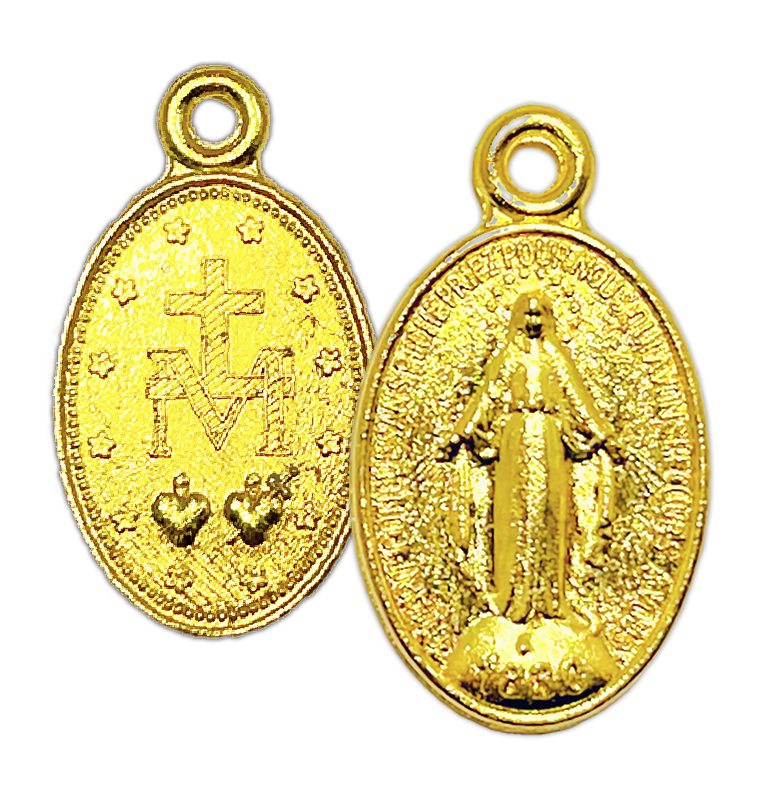 For Catholics worldwide, the Miraculous Medal stands as an enduring symbol of faith, hope, and the divine intercession of the Blessed Virgin Mary. It's not just a piece of religious jewelry; it's an emblem of belief, a testament to miracles, and a tangible connection to the Mother of God.
For Catholics worldwide, the Miraculous Medal stands as an enduring symbol of faith, hope, and the divine intercession of the Blessed Virgin Mary. It's not just a piece of religious jewelry; it's an emblem of belief, a testament to miracles, and a tangible connection to the Mother of God.
The story of the Miraculous Medal unfolds against a backdrop of religious visions, reported miracles, and profound devotion, offering a remarkable narrative that has inspired millions of the faithful over nearly two centuries.
Origins and History
The Miraculous Medal has its origins in the apparitions of the Virgin Mary reported by Saint Catherine Labouré, a humble novice of the Daughters of Charity, in 1830, in Paris, France. The Blessed Virgin appeared to St. Catherine three times, presenting a vision of a medal that would become a symbol of faith for Catholics worldwide.
The front of the medal was to feature the Blessed Virgin standing on a globe, with rays of light streaming from her hands, surrounded by the words "O Mary, conceived without sin, pray for us who have recourse to thee."
The reverse would display a large "M" surmounted by a bar and a cross, beneath which were the Sacred Heart of Jesus crowned with thorns and the Immaculate Heart of Mary pierced with a sword, and around the edge, twelve stars.
Impressed by the authenticity of St. Catherine's visions, her spiritual director, Father Aladel, sought approval from the Church to strike the medal. The first medals were made in 1832, and their distribution coincided with a cholera epidemic that had hit Paris. Many who wore the medal reported miraculous cures, leading to the popular name "Miraculous Medal."
Miracles of the Miraculous Medal
Since its inception, numerous miracles have been attributed to Miraculous Medals. The first miracle was the reported healing of a young worker's broken arm in 1832. The worker, an acquaintance of St. Catherine, was advised to wear the medal and was miraculously healed.
Another famous miracle is the conversion of Alphonse Ratisbonne, a Jewish banker who was vehemently anti-Catholic. After reluctantly agreeing to wear the medal and recite the Memorare prayer, he experienced a vision of the Virgin Mary that led him to convert to Catholicism and later become a priest.
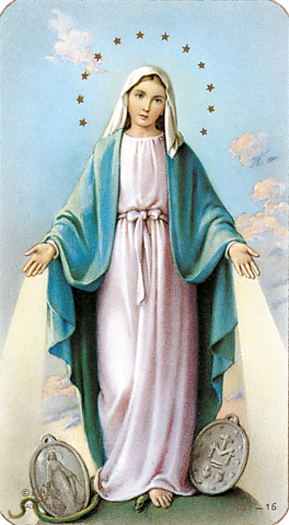 Apparitions and the Miraculous Medal
Apparitions and the Miraculous Medal
The apparitions of the Virgin Mary to St. Catherine are deeply intertwined with the history and significance of the Miraculous Medal. The first apparition occurred in the chapel of the Motherhouse of the Daughters of Charity on Rue du Bac, Paris, on July 18, 1830. During the second and third apparitions, in November 1830, the Virgin Mary instructed St. Catherine to have the medal struck.
Since then, the Miraculous Medal has been one of the most popular religious medals in the world. These apparitions have been approved by the Church and are commemorated annually by the faithful, particularly at the Chapel of Our Lady of the Miraculous Medal in Paris, which has become a popular pilgrimage site.
Wearing the Miraculous Medal
Many Catholics wear the Miraculous Medal as a sign of their devotion to the Blessed Virgin Mary and as a request for her maternal protection and intercession. They believe that those who wear it will receive great graces, especially if they wear it around the neck, as instructed by the Virgin Mary in her apparition to St. Catherine.
CatholicShop.com carries numerous styles of the Miraculous Medal. Browse our Miraculous Medals today.
Miraculous Medals For Sale
Gold Miraculous Medals
Sterling Silver Miraculous Medals
White Gold Miraculous Medals
Gold-Filled Miraculous Medals
St. Catherine Labouré: Visionary of the Miraculous Medal
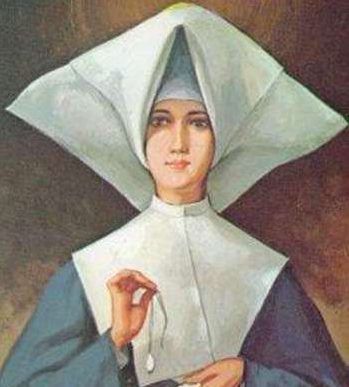 St. Catherine Labouré, a name renowned across the globe among Catholics, is revered as the humble nun who introduced the world to the Miraculous Medal. The Blessed Virgin Mary chose her as the instrument to spread this remarkable symbol of faith and devotion. Her life story, characterized by simplicity, obedience, and faith, serves as an inspiration to the faithful.
St. Catherine Labouré, a name renowned across the globe among Catholics, is revered as the humble nun who introduced the world to the Miraculous Medal. The Blessed Virgin Mary chose her as the instrument to spread this remarkable symbol of faith and devotion. Her life story, characterized by simplicity, obedience, and faith, serves as an inspiration to the faithful.
Catherine Labouré was born on May 2, 1806, in the small village of Fain-lès-Moutiers, in the Burgundy region of France. The ninth of eleven children, she lost her mother at a tender age of nine.
According to some accounts, upon her mother’s death, Catherine climbed onto a chair and tenderly embraced a statue of the Blessed Virgin, imploring, “Now, dear Blessed Mother, you will be my mother!” This encounter marked the beginning of a special relationship she would share with the Virgin Mary.
Vocation and Life as a Nun
Inspired by the dreams of St. Vincent de Paul, Catherine decided to dedicate her life to serving God. In 1830, at the age of 24, she was admitted to the Daughters of Charity in Paris, taking the religious name Sister Catherine.
Her life as a nun was not extraordinary. She was assigned to work in the hospice for elderly men, a job she carried out diligently and without complaint. She was known for her humility, often seeking the lowliest tasks. Despite her humility, her life was about to take a turn that would impact the world profoundly.
Apparitions of the Virgin Mary
In July of 1830, Catherine reported her first of three apparitions of the Virgin Mary. It occurred in the community’s motherhouse chapel on the Rue du Bac. During the second and third apparitions in November, Mary showed Catherine a vision of what would become known as the Miraculous Medal. She instructed Catherine to have a medal struck after this model, promising great graces to all who wore it.
Mary’s message to Catherine was one of urgency and dire warning. She spoke of future tribulations in France, entrusting Catherine with the mission to spread the devotion of the medal as a tool of faith and salvation.
The Miraculous Medal and the Spread of the Devotion
Although initially met with skepticism, Catherine’s confessor, Father Aladel, was eventually convinced of the authenticity of her visions. He obtained the Church’s permission to produce the medal in 1832.
The Miraculous Medal was disseminated quickly, largely due to the cholera epidemic that hit Paris shortly after the medals were made. Those who wore the medal and invoked Mary’s intercession reported numerous miracles, mainly inexplicable healings.
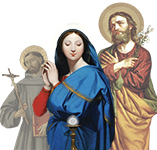 St. Catherine’s Later Life and Legacy
St. Catherine’s Later Life and Legacy
Following the apparitions, Catherine returned to her quiet life, her identity as the visionary of the Rue du Bac remaining a secret. She continued her work at the hospice, caring for the sick and the elderly, fulfilling her duties with simplicity and humility.
It was not until shortly before her death in 1876 that Catherine revealed herself as the nun who had received the visions of the Miraculous Medal. Upon her death, her body was found to be incorrupt and remains so to this day, on display at the Chapel of Our Lady of the Miraculous Medal in Paris.
Humility and Faith
St. Catherine Labouré’s life is a powerful testament to humble obedience and unshakeable faith. Her story continues to inspire millions, while the Miraculous Medal, her most tangible legacy, remains a significant part of Catholic devotion, inviting all to experience the profound love and protection of the Blessed Virgin Mary.
Unique Miraculous Medals
Colorful Miraculous Medals
Low-Price Miraculous Medals
Miraculous Medal Rosaries
Miraculous Medal Pins
Miraculous Medal Rings
Miraculous Rosary Centers
All Miraculous Medal Items

Miraculous Medals in Bulk
 The Meaning of the Miraculous Medal
The Meaning of the Miraculous Medal
from the Association of the Miraculous Medal
The Front
Mary is standing upon a globe, crushing the head of a serpent beneath her foot. She stands upon the globe, as the Queen of Heaven and Earth. Her feet crush the serpent to proclaim Satan and all his followers are helpless before her (Gn 3:15). The year of 1830 on the Miraculous Medal is the year the Blessed Mother gave the design of the Miraculous Medal to Saint Catherine Labouré. The reference to Mary conceived without sin supports the dogma of the Immaculate Conception of Mary—not to be confused with the virgin birth of Jesus, and referring to Mary’s sinlessness, “full of grace” and “blessed among women” (Luke 1:28)—that was proclaimed 24 years later in 1854.
The Back the Medal
The twelve stars can refer to the Apostles, who represent the entire Church as it surrounds Mary. They also recall the vision of Saint John, writer of the Book of Revelation (12:1), in which “a great sign appeared in heaven, a woman clothed with the sun, and the moon under her feet, and on her head a crown of 12 stars.” The cross can symbolize Christ and our redemption, with the bar under the cross a sign of the earth. The “M” stands for Mary, and the interleaving of her initial and the cross shows Mary’s close involvement with Jesus and our world. In this, we see Mary’s part in our salvation and her role as mother of the Church. The two hearts represent the love of Jesus and Mary for us. (See also Lk 2:35).
Bestsellers
Recently Viewed
Newsletter
Help
Info
Testimonials
I just wanted to thankyou for the Cobalt Blue bracelet that I ordered for my wife. It came in the mail just like you said it would, right on time. It was exactly what she wanted to the T. Thank you once again David Bauler
David Bauler
MY HEART WILL TRIUMPH is the best book that I have read since 1987 about Medjugorje. Every adult should try to read it to see the hope that Our Blessed Mother gives everyone who prays. Mirjana used prayer to escape from so many life-threatening events as you will see, especially communism. In the book the Queen of Peace continues her...
Kathie Duggan
Radio Maria
I ordered 5 tiny saints charms and 2 miraculous medal prayer card sets last Saturday (June 12, 2020) and I received all items today (June 17, 2020). Catholicshop.com\'s service is quick and accurate and the items that arrived were all in good condition. Thank you so much, catholicshop.com! I really appreciate how speedy the shipment was and how...
Angela P.
I have purchased several items from you folks. The quality is unbelievable and the service matches that quality. The prices are so much lower than a standard jewelry store and again the quality is way better. They are outstanding. as a gift. Thank you all and have a blessed holiday season. Bob Cretella
Robert Cretella
My Mother gave this same medal to me 50 yrs ago for my First Communion. I loved it so! While outside playing, I lost it and was heart sick. I recently needed to purchase a gift for our Grand Niece's Communion and I saw the same Medal! It was such a beautiful sight to my heart. I bought her one and she loves it, now I am purchasing one for me, to...
Michele
Copyright © 2005-2025 Catholic Shop.







